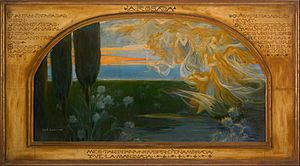Adrià Gual facts for kids

Adrià Gual i Queralt (born in Barcelona, 1872 – died 1943) was a very important person in Catalan theatre and art. He was a talented playwright (someone who writes plays) and also a theatre businessman. He started the Escola Catalana d'Art Dramàtic (Catalan School of Dramatic Art). Adrià Gual was also one of the first people to work with cinema in Barcelona.
Gual created a theatre group called El Teatre Íntim (The Intimate Theatre). He also led the Catalan School of Drama. In 1913, he became the artistic director for a film company called Barcinógrafo. After he passed away, his memories were published in a book called Mitja vida de teatre (Half Life Theatre, 1960).
Adrià Gual was also a skilled artist. He painted in a style called Modernism, which often used symbols. One of his famous paintings is "La rosada" (The Dew). He was also known for his amazing posters. Many of his works are kept at the Library of Catalonia. This includes twelve oil paintings he made around 1902 for the Wagnerian Association.
Contents
Making Catalan Theatre Great
Adrià Gual worked hard to make Catalan theatre as respected as theatre in other countries. He wanted to create a collection of plays that included both classic works and new Catalan plays. He brought plays by famous writers like Aeschylus, Molière, Shakespeare, and Goethe to the Catalan stage. He also supported Catalan writers like Maragall, Àngel Guimerà, and Santiago Rusiñol.
The School of Dramatic Art
To help theatre grow, Gual founded the Escola Catalana d'Art Dramàtic (School of Dramatic Art) in 1913. This school was very important because it was the first place dedicated to teaching performing arts in Catalonia. It later became the Institut del Teatre (Theatre Institute) that exists today.
Gual wanted to bring new ideas to Catalan theatre. He was inspired by many different artists. These included writers like Henrik Ibsen and Maurice Maeterlinck, and even the composer Richard Wagner. He also looked at the works of Gabriele d'Annunzio and Gerhart Hauptmann.
Gual's Plays
Adrià Gual started writing plays when the Modernist art movement was popular. His early plays were often poetic and had a dreamy, symbolic feel. Plays like Nocturn. Andante. Morat (1896) and Silenci (1898) had a mysterious mood. They often connected music, colors, and words in interesting ways.
His play Misteri de dolor (Mystery of Pain, 1904) marked a new time in his career. After this, Gual started writing plays that were more realistic. They often showed everyday life and social issues, like Els pobres menestrals (The Poor Workers, 1908).
He also explored different types of plays. With Blancaflor (1899), he mixed old myths with songs. He even wrote comedies, like Les alegres comediantes (The Merry Comedians, 1905). Gual also wrote poetic plays, which used verse and created magical, legendary settings. An example of this is Donzell qui cerca muller (Young Man Seeking a Wife, 1910).
In short, Adrià Gual helped to make Catalan arts more modern and respected in the 20th century.
Theater Works
Here are some of the plays written by Adrià Gual:
- Oh, Estrella! (1891)
- La mosca vironera (1891)
- La visita (1893)
- L'últim hivern (1893)
- La mar brama (1894)
- Morts en vida (1894)
- El perill (1895)
- Nocturn (Audante Morat) (1895)
- Blancaflor(1897)
- Silenci (Drama de món) (1898)
- L'emigrant (1900)
- Camí d'Orient (1901)
- Misteri de dolor (1901)
- Les alegres comediantes (1902)
- La fi de Tomàs Reynald (1904)
- Els pobres menestrals (1906)
- Marcolf (1907)
- La pobra Berta (1907)
- Donzell qui cerca muller (1910)
- En Jordi Flama (1911)
- L'Arlequí vividor (1912)
- La comèdia extraordinària de l'home que va perdre el temps (1913)
- La gran família (1915)
- Els avars (1916)
- Shumann al vell casal (1916)
- Els pastors en revolta (1916)
- Les filoses (1916)
- La serenata (1916)
- Joan Ezequiel (1916)
- Hores d'amor i de tristesa (1916)
- Fígaro o la dama que s'avorria (1917)
- La mentidera (1927)
- El camí (1939)
See Also
 In Spanish: Adrián Gual para niños
In Spanish: Adrián Gual para niños


